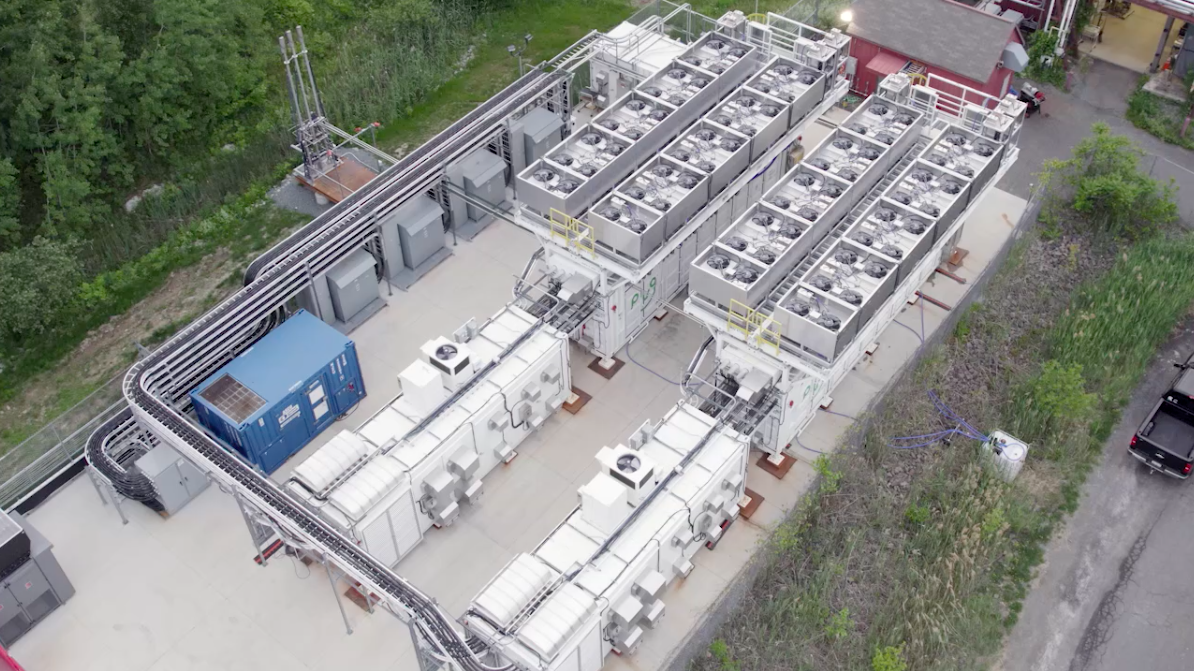Plug Power, working in partnership with Microsoft, built a 3 MW fuel cell system capable of displacing a diesel generator at a data center in case of a power outage. The fuel cell systems developer designed and manufactured the 125 kW proton exchange membrane (PEM) fuel cells in in Latham, New York. The company packed 36 fuel cells into a pair of 12-meter long shipping containers, each holding 18. “What we just witnessed was, for the data center industry, a moon landing moment. We have a generator that produces no emissions,” said Sean James, Microsoft's director of data center research. Microsoft turned to PEM fuel cells as a potential solution to the backup diesel generator challenge in 2018 because PEM fuel cells are quick to turn on and off. Plug Power explained to pv magazine that the 36 fuel cells are the largest Plug has ever made, and the 3 MW fuel cell system is Plug's biggest application. Microsoft wants to eliminate diesel from its operations by 2030 and, given recent cost reductions in fuel cell technology, hydrogen offers an increasingly viable route.
Spain's Cepsa and India's Ohmium have announced an agreement to develop “highly efficient” green hydrogen projects in the Iberian Peninsula. “The companies will collaborate to develop and build initially small-scale projects aiming to develop a green hydrogen platform using Ohmium's advanced modular PEM electrolyzers, with the possibility of providing Cepsa up to 300 MW of installed hydrogen production capacity,” wrote the Spanish mobility and energy company, announcing its first renewable hydrogen project. In its Positive Motion plan, Cepsa plans to develop 2 GW of green hydrogen production in Spain and Portugal by 2030.
The University of Texas at San Antonio (UTSA) and Southwest Research Institute said they are working on creating high surface area carbon (HiSAC) microstructure particles that can physically and chemically absorb hydrogen. The researchers argue that HiSAC would allow safe transportation, cheaper than existing options. Previous research has demonstrated HSAC microstructures at high temperatures and low pressures, but the team will work on forming these materials at room temperature in a scalable manner. “This process uses less energy than it takes to power an incandescent light bulb,” UTSA professor Josh Mangum commented. UTSA will perform the analytical characterization of the microparticle structures. Mayer's research team will perform a detailed structural characterization of the materials.
Norway's Teco2030 and Germany's AVL List have signed a collaboration agreement that will see Teco2030's fuel cell stacks deployed on AVL's DemoTruck, powered by the HyTruck Fuel Cell System. “The DemoTruck project is currently constructing a prototype class 8/40-ton truck with outstanding power density capabilities, which provides a perfect form factor to enable integration of over 300 kW net fuel cell systems into standard truck chassis. The DemoTruck prototype will be on the road in mid-2023,” wrote the Norwegian company.
West Australian company Hybrid Systems Australia has signed an agreement with Charles Darwin University to deliver a 5 kW fuel cell with an 8 kWh hydrogen storage system as part of a pilot project. The system will be housed at the Renewable Energy Grid Testing Facility in East Arm Wharf. “The Hydrogen Energy Storage System (HESS) is a first for the Northern Territory,” wrote Charles Darwin University, which will operate the system.
Kenyan electricity generating company Kenya Power published a request for proposals for consultancy services to undertake a feasibility study for green hydrogen, ammonia and fertilizer production and its pilot plant at Olkaria, Kenya.
Babcock & Wilcox has signed an agreement with Newpoint Gas to serve as a foundational technology partner and provide hydrogen generation, decarbonization and combustion technologies for a $1.51 billion complex that will be developed at the former U.S. Department of Energy Portsmouth Gaseous Diffusion Plant site near Piketon, Ohio.
The Fuel Cells and Hydrogen Observatory (FCHO) will be renamed the European Hydrogen Observatory. “The primary role of the observatory will be to act as the European one-stop source of information for hydrogen,” wrote the Clean Hydrogen Joint Undertaking. European institutions published a second public procurement, aiming to acquire services for further developing the platform. Companies have till August 26 to take part in the tender.
This content is protected by copyright and may not be reused. If you want to cooperate with us and would like to reuse some of our content, please contact: editors@pv-magazine.com.



2 comments
By submitting this form you agree to pv magazine using your data for the purposes of publishing your comment.
Your personal data will only be disclosed or otherwise transmitted to third parties for the purposes of spam filtering or if this is necessary for technical maintenance of the website. Any other transfer to third parties will not take place unless this is justified on the basis of applicable data protection regulations or if pv magazine is legally obliged to do so.
You may revoke this consent at any time with effect for the future, in which case your personal data will be deleted immediately. Otherwise, your data will be deleted if pv magazine has processed your request or the purpose of data storage is fulfilled.
Further information on data privacy can be found in our Data Protection Policy.